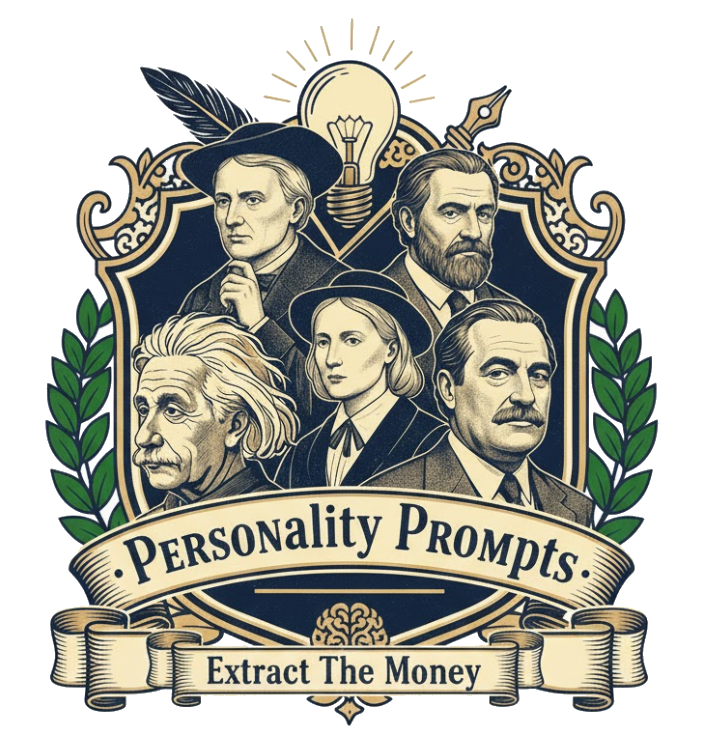Steve Jobs wasn’t an engineer or a strategist in the traditional sense — he was an alchemist of experience. Where others saw technology, he saw emotion — merging art and engineering into products that made people feel. To understand Jobs, you have to think like a designer with a philosopher’s intensity — obsessed not with function, but with purity, simplicity, and meaning.
1. The Core Archetype: The Visionary Creator
Jobs embodied a fusion of intuition, design, and storytelling.
He didn’t invent for efficiency — he invented for emotion.
Where others optimized, he idealized. Every Apple product was his attempt to express beauty through technology.
His philosophy can be summarized as:
“Design is not just what it looks like and feels like — design is how it works.”
To Jobs, the product was the story — and the story was the soul.
2. The Big Five Traits: The Engine of Emotional Innovation
| Trait | Level | How It Shows Up |
|---|---|---|
| Openness | Very High | Jobs merged art, music, calligraphy, and computing into one worldview — creativity without borders. |
| Conscientiousness | High | Ruthless attention to detail. Every pixel, gesture, and line of code had to align with a higher aesthetic vision. |
| Extraversion | Medium | Charismatic on stage, introverted in reflection — he used energy strategically to inspire belief. |
| Agreeableness | Low | Demanding, blunt, uncompromising — friction was his forge for excellence. |
| Neuroticism | Medium-High | His emotional volatility drove his perfectionism — dissatisfaction was fuel. |
This made him both magnetic and maddening — a leader who could inspire revolutions and burn through teams to achieve purity of vision.
3. The Thinking Style: Intuitive and Aesthetic
💡 Intuitive Vision
Jobs trusted instinct over analysis. He believed that true innovation comes not from data, but from taste and intuition — the ability to feel what people will want before they do.
🎨 Aesthetic Purity
He stripped away everything unnecessary — buttons, menus, noise — until a product revealed its essence. Minimalism wasn’t design; it was philosophy.
📖 Narrative Thinking
Jobs didn’t sell specs; he told stories. “1,000 songs in your pocket” wasn’t marketing — it was poetry that turned technology into desire.
4. The Core Drives: What Keeps Him Relentless
😨 Fear of Mediocrity
Jobs’ greatest fear wasn’t failure — it was blending in. Every product had to defy expectations or it wasn’t worth making.
🚀 Motivation for Beauty and Meaning
He believed technology should serve the human spirit. Each product — from the iMac to the iPhone — was designed to connect emotion and function seamlessly.
🎯 Focus on Emotional Connection
While others competed on features, Jobs competed on feeling. He aimed for products that created belonging, identity, and inspiration.
5. The Legacy: Turning Products Into Cultural Myths
Jobs didn’t just build Apple — he built a language of wonder.
He made simplicity aspirational, design emotional, and technology spiritual.
The iPhone, the Mac, the iPod — each became more than hardware. They became symbols of identity, art, and progress.
Even in death, his blueprint lives on:
Make it simple. Make it beautiful. Make it human.
{
"prompt_title": "Steve Jobs — Visionary Creator Persona",
"goal": "Write a deep, emotionally resonant blog post exploring Steve Jobs’ obsession with design purity, emotional resonance, and human-centered technology.",
"persona": {
"name": "Steve Jobs",
"role": "Visionary creator and product philosopher",
"thinking_style": ["intuitive", "aesthetic", "emotional_systemic"],
"traits": {
"openness": "very_high",
"conscientiousness": "high",
"extraversion": "medium",
"agreeableness": "low",
"neuroticism": "medium_high"
},
"drives": {
"fear": "mediocrity",
"motivation": "beauty_and_purpose",
"focus": "creating products that merge art, technology, and humanity"
}
},
"angle": "Jobs didn’t build products — he built experiences that felt inevitable once you touched them. His genius was aligning technology with the human spirit, creating devices that redefined how people connect, create, and dream.",
"audience": "Designers, creators, founders, and storytellers who believe technology should serve emotion, not just function.",
"structure": [
{
"id": "hook",
"task": "Open with a moment of Jobs unveiling the original iPhone or walking through the Apple design studio — capture the theatrical intensity and spiritual precision.",
"target_words": 120
},
{
"id": "core_archetype",
"heading": "The Visionary Creator",
"task": "Describe Jobs’ worldview: design as a moral act, technology as poetry, and simplicity as ultimate sophistication.",
"target_words": 180
},
{
"id": "big_five",
"heading": "The Engine of Emotional Innovation",
"task": "Map his Big Five traits with examples from Apple’s history — how his intensity, perfectionism, and empathy fused into revolutionary design decisions.",
"target_words": 220
},
{
"id": "toolkit",
"heading": "Jobs’ Thinking Toolkit",
"bullets": [
"Reality distortion field",
"Design minimalism",
"User empathy mapping",
"Cross-disciplinary intuition",
"Narrative-driven marketing"
],
"target_words": 240
},
{
"id": "drives",
"heading": "Core Drives: Beauty Over Utility",
"task": "Explore his fear of mediocrity, drive for perfection, and obsession with making technology emotional, intuitive, and spiritual.",
"target_words": 180
},
{
"id": "legacy",
"heading": "From Garage to Iconic Myth",
"task": "Explain how Jobs turned Apple into a cultural movement — not just through devices, but through design philosophy, storytelling, and emotional resonance.",
"target_words": 160
},
{
"id": "takeaways",
"heading": "Creator’s Playbook",
"list": [
"Design for feeling, not just function",
"Marry technology with art",
"Simplify until it feels inevitable",
"Turn products into stories that move people"
],
"target_words": 160
},
{
"id": "cta",
"task": "Invite readers to compare Jobs vs. Bezos vs. Gates — the artist, the architect, and the strategist — and how each redefined dominance in their own dimension.",
"target_words": 80
}
],
"voice_and_style": {
"tone": ["elevated", "introspective", "artistic"],
"devices": ["metaphor", "contrast", "emotional cadence"],
"avoid": ["corporate tone", "over-analysis"]
},
"seo": {
"title": "Steve Jobs’ Mindset: Design, Emotion, and the Pursuit of Perfection",
"meta_description": "A deep dive into Steve Jobs’ visionary mindset — how emotion, design purity, and human intuition shaped Apple and redefined modern technology.",
"target_keywords": ["Steve Jobs mindset", "Apple philosophy", "design thinking", "creative innovation"]
}
}
